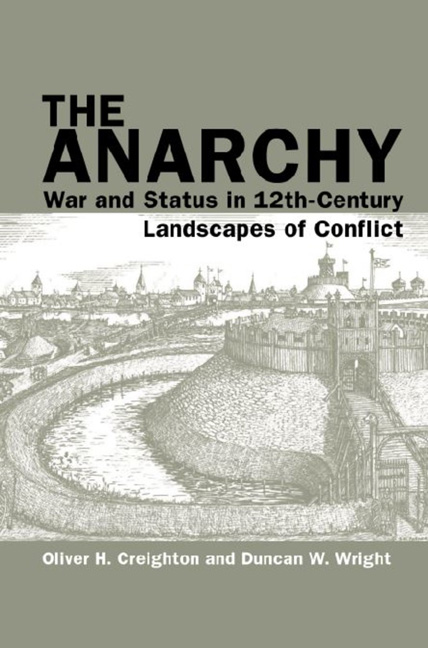Book contents
- Frontmatter
- Contents
- Acknowledgements
- List of Figures
- List of Colour Plates
- Chapter 1 Introduction
- Chapter 2 Historical Outline and the Geography of ‘Anarchy’
- Chapter 3 Waging War: Fields of Conflict and Siege Warfare
- Chapter 4 Architecture and Authority: Castles
- Chapter 5 Material Culture: From Arts to Coins
- Chapter 6 Performing Violence: Arms, Armour and Military Apparel
- Chapter 7 Faith and Fortification: The Church
- Chapter 8 Town, Village and Country
- Chapter 9 Anarchy on the Fen Edge: Case Study of the Isle of Ely
- Chapter 10 The Twelfth-Century Civil War in Context: Assessment and Reassessment
- Appendix Key Sites to Visit
- Bibliography
- Index
- Plate section
Chapter 3 - Waging War: Fields of Conflict and Siege Warfare
- Frontmatter
- Contents
- Acknowledgements
- List of Figures
- List of Colour Plates
- Chapter 1 Introduction
- Chapter 2 Historical Outline and the Geography of ‘Anarchy’
- Chapter 3 Waging War: Fields of Conflict and Siege Warfare
- Chapter 4 Architecture and Authority: Castles
- Chapter 5 Material Culture: From Arts to Coins
- Chapter 6 Performing Violence: Arms, Armour and Military Apparel
- Chapter 7 Faith and Fortification: The Church
- Chapter 8 Town, Village and Country
- Chapter 9 Anarchy on the Fen Edge: Case Study of the Isle of Ely
- Chapter 10 The Twelfth-Century Civil War in Context: Assessment and Reassessment
- Appendix Key Sites to Visit
- Bibliography
- Index
- Plate section
Summary
THE DISTRIBUTION of the different types of documented conflict events recorded in England and Wales between 1135 and 1153 is mapped in Figures 3.1a–c. These make clear both the large number and wide variety of military clashes during the conflict. Despite its duration, pitched battles were singularly rare and sieges dominated the military landscape in a conflict that was tightly focused in distinct regions. This chapter explores the landscape context of military engagement. It combines analysis of the documentary sources with scrutiny of the places of battle and the material traces of warfare to reconstruct the conduct of conflict and reveal something of its underestimated psychological and symbolic aspects (the arms and armour of the military forces of the period are examined separately in Chapter 6). Following an overview of the settings of conflict and an assessment of the two most significant battlefields (the Battle of the Standard or Northallerton, 1138, and the Battle of Lincoln, 1141), the chapter goes on to explore siege warfare in particular detail. It concludes with a case study of Wallingford, Oxfordshire, one of the most bitterly contested sites of the conflict.
Landscapes of War: Settings and Contexts
Attitudes to the conduct of medieval warfare were inextricably fused to religious belief.The momentum to regulate warfare in north-west Europe in the eleventh and early twelfth centuries amounted to what some scholars have styled a ‘peace movement.’ By the first quarter of the twelfth century, the First Crusade had done much to rehabilitate the social validity of the bellatores in the eyes of the Church, but for ecclesiastical traditionalists, much acquainted with classical precedents of military discipline and service to the state, contemporary knighthood had become the antithesis of its divinely ordained function and the Church acted to regulate the excesses of conflict. The Church deemed that the appropriate role of the bellatores was not restricted to the defence of Christendom's frontiers against external enemies, but extended to the protection of the poor and helpless and, above all, the Church.The repression of pillage and exactions, respect for the Church's possessions and the establishment of protocols for truces all featured in new attitudes to warfare linked to an emerging chivalric culture.
- Type
- Chapter
- Information
- The AnarchyWar and Status in 12th-Century Landscapes of Conflict, pp. 34 - 79Publisher: Liverpool University PressPrint publication year: 2017

